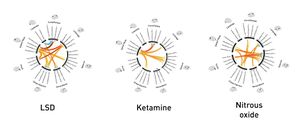Nitrous Oxide: Difference between revisions
From BurnZero
(Created page with "'''Since the 19th century, nitrous oxide, also referred to as laughing gas, has been used in medicine as an anaesthetic to lessen pain. However, in smaller doses, it can cause mind-altering experiences, similar to those brought on by the psychedelic drugs ketamine and LSD.''' These effects include feelings of bliss, spirituality, and a sense of being outside of one's body.") |
mNo edit summary |
||
| Line 1: | Line 1: | ||
[[File:Nitrous oxide, ketamine, and LSD.jpg|alt=Compare the effects of nitrous oxide, ketamine, and LSD on functional connectivity:|thumb|'''Figure 1'''. Comparative effects of nitrous oxide, ketamine, and LSD on functional connectivity:]] | |||
'''Since the 19th century, nitrous oxide, also referred to as laughing gas, has been used in medicine as an anaesthetic to lessen pain. However, in smaller doses, it can cause mind-altering experiences, similar to those brought on by the [[Psychedelics|psychedelic]] drugs [[ketamine]] and [[LSD]].''' These effects include feelings of bliss, spirituality, and a sense of being outside of one's body. | '''Since the 19th century, nitrous oxide, also referred to as laughing gas, has been used in medicine as an anaesthetic to lessen pain. However, in smaller doses, it can cause mind-altering experiences, similar to those brought on by the [[Psychedelics|psychedelic]] drugs [[ketamine]] and [[LSD]].''' These effects include feelings of bliss, spirituality, and a sense of being outside of one's body. | ||
Revision as of 10:30, 14 May 2023
Since the 19th century, nitrous oxide, also referred to as laughing gas, has been used in medicine as an anaesthetic to lessen pain. However, in smaller doses, it can cause mind-altering experiences, similar to those brought on by the psychedelic drugs ketamine and LSD. These effects include feelings of bliss, spirituality, and a sense of being outside of one's body.
